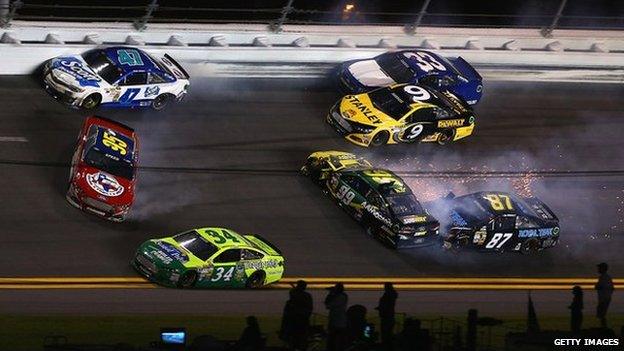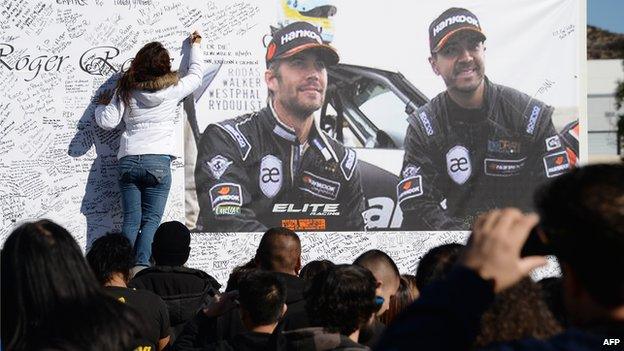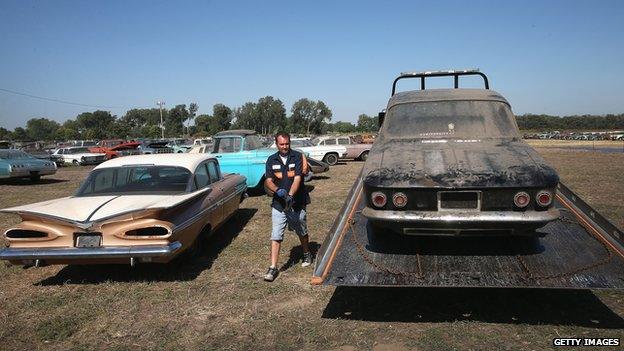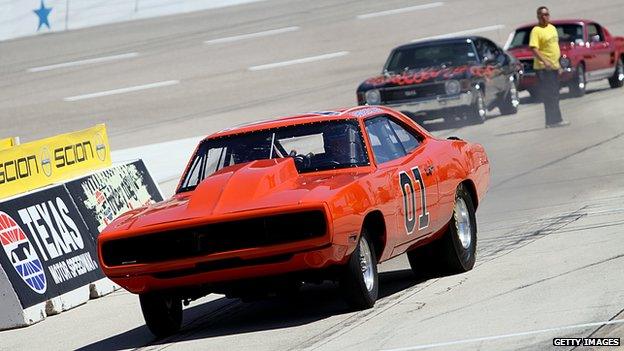Why the US is addicted to fast cars and street racing
- Published

Nascar is now a $3bn industry, but it grew out of the bootlegging trade
Film and TV star Idris Elba - best known as Stringer Bell from The Wire - has been touring the US as part of a series about the history of underground racing. It turns out the American obsession with speed dates back to the Prohibition era.
The recent death of Fast and Furious actor Paul Walker in a car crash in California has highlighted the popularity not just of the film franchise but also of street racing.
But ever since automobile production began in Detroit there has been a temptation to speed.
Daniel Pierce, a professor of history at the University of North Carolina, says: "I don't think the love of speed was so much an effort to thumb your nose at the authorities, although that was part of it.
"Speed was tied up with masculinity for a lot of young males. Especially in the south, and in southern California, to make a car go fast and to be able to control it was a sign of masculinity."
Prof Pierce, editor of Real Nascar: White Lightning, Red Clay, and Big Bill France, adds: "[Nascar driver] Richard Petty once said the first automobile race was when the second cat got his car."
The first mass-produced car was the Curved Dash Oldsmobile, external, which had a top speed of only 20mph (30km/h), and went into production in 1901.
That same year, the state of Connecticut introduced a 12mph speed limit.
Idris Elba drives a racing car around Watkins Glen track in New York
Seven years later, Henry Ford brought out the Model T which, with the pedal to the metal, could reach 45mph.
Over the following 19 years he would produce 15 million Model Ts from a factory in Detroit.
But the 1920s and 1930s was the era of Prohibition and the bootleggers bringing whiskey in from Canada or transporting it across "dry" states needed faster cars to outwit the police and federal agents.

The death of Paul Walker and his friend Richard Rodas highlighted the popularity of street racing
"You had to have fast cars to haul your whiskey to the people and to get away from the revenue and the ABC [Alcoholic Beverage Control commission] and the federal officers," says Junior Johnson, a former bootlegger from North Carolina who became a legend in the world of Nascar racing.
"If it hadn't been for whiskey, Nascar wouldn't have been formed. That's a fact," adds Johnson, who was jailed a year after he began his Nascar career, for running an illegal whiskey still, a crime that was pardoned 30 years later by President Ronald Reagan.
While Al Capone was shuttled around Chicago in a bulletproof Cadillac, external, his underlings would outrun the Feds in a Chevrolet Mercury or a Packard DeLuxe Roadster, which could reach 70mph or 100mph respectively.
In 1934, a year after Ford introduced the V8 cabriolet - which could do 80mph - he received a letter from bank robber Clyde Barrow, of Bonnie and Clyde fame.
Barrow wrote that the V8 was a "dandy car" and added: "For sustained speed and freedom from trouble the Ford has got every other car skinned."
After the war there was a boom in the number of people owning cars in the US and some of these motorists wanted to drive fast and even race each other.
Illegal street racing became popular in the 1950s and dozens of drivers and spectators were killed during that decade.
The authorities in California encouraged Wally Parks when he set up the National Hot Rod Association, external, which promoted drag racing in safe, off-street tracks.
While drag racing was taking off on the west coast, the National Association for Stock Car Auto Racing (Nascar) had been formed in Florida in 1948 and went from strength to strength.
A third genre, Indy car racing - akin to Europe's Formula 1 - suffered a setback in 1957 when, two years after the Le Mans disaster in France which killed 77 spectators, external, US car manufacturers were banned from taking part in the sport.
Nowadays Nascar is the second most lucrative sport in the US, behind American football, with top drivers such as Dale Earnhardt Jr earning $25m (£15m) a year.
Nascar was traditionally most popular in the southern US but it has in recent years, external attracted fans from Michigan, California and Arizona.
But despite the popularity of Nascar and drag racing, there remains a sub-culture devoted to illegal street racing.

The Chevrolet Corvair (right) was fitted with a turbocharger but withdrawn in 1969
In 2001 - the same year the first Fast and Furious film came out - the National Highway Traffic Safety Administration (NHTSA) reported that police listed street racing as a factor in 135 fatal crashes, up from 72 the previous year. But the NHTSA does not keep street racing data.
NHTSA spokesman David Strickland says: "Motorists who drive at excessive speeds put themselves and others at an increased risk of being involved in a crash and possibly of being injured or killed."
Actor Idris Elba, who adopted a Baltimore accent for the TV series The Wire but grew up in London's East End, went to meet some street racers in Detroit and says: "I don't condone what they do, I can see why they do it. It is very exciting."
But Prof Pierce says street racing is nowhere near as popular nowadays as it was in his youth. "You can do it in a video game now and it's a little safer," he says.
He adds: "I don't think there is quite the car culture that you had in the 50s, 60s or 70s. It's hard to work on your own car any more because everything is computerised and young men don't seem to be so tied to cars as they were when I grew up."
Elba, whose father was a shop steward at the enormous Ford factory in Dagenham, east London, says: "Cars, racing, speed, they are and have been for many people throughout history, a way of life - either a means to make a living, or a means to escape.
"I'm addicted to speed, it's no secret, but whilst travelling, listening, learning and telling these amazing stories, what surprised me the most, was just how far people are willing to go, the risks people are willing to take, to satisfy that addiction."
In 1971 a group of mavericks, led by Brock Yates Sr, started the Cannonball Run - which was later fictionalised in a highly successful movie with Burt Reynolds and an all-star cast - involved a 2,800 mile coast-to-coast race.
It was named after Erwin "Cannonball" Baker, who had set a record of 53 hours for the drive in 1933.
Yates and co-driver Dan Gurney - winner of the 1967 Le Mans 24-hour race in France - cut that time to 35 hours and 54 minutes and amazingly picked up only one speeding fine.
Yates's son, Brock Jr, says: "Cannonball was started for two reasons - to prove that good drivers could traverse long distances at high speed safely... and a protest against the [proposed] 55[mph speed limit]."
But despite protests such as the Cannonball Run, President Richard Nixon introduced a national speed limit of 55mph (88kph) in 1973.
The limit has very little to do with safety. It was introduced as a result of the oil crisis, external triggered by the 1973 Arab-Israeli War.
Driving slower conserved fuel and with the US facing oil shortages there was an urgent need to cut speed.
But many car enthusiasts believed driving fast was as American as apple pie and the US government gradually backtracked on the 55mph limit.

Drag racing was introduced after a number of deaths through street racing in the 1950s
In 1987 it went up to 65mph and in 1995 it was scrapped altogether, with power being passed back to individual states.
Nowadays speed limits range from 60mph in Hawaii to 80mph in Utah.
In October last year Texas granted permission for an 85mph limit on a new toll road, external between Austin and San Antonio.
Scot Keller, chief curator of the LeMay Museum in Tacoma, Washington,, external says higher speed limits tend to be allowed in states with "vast open spaces".
"The enthusiasm for films like Fast and Furious show that people like to do things that are dangerous or outside of the norm.
"Young people who are racing these performance cars, the tuner cars, the muscle cars, are very much like the hot-rodders in the 1950s. But they are starting with vehicles which involve computers and more sophisticated engines," says Mr Keller.
Watch the first episode of Idris Elba: King of Speed on the BBC iPlayer.
Follow @BBCNewsMagazine, external on Twitter and on Facebook, external
On a tablet? Read 10 of the best Magazine stories from 2013 here